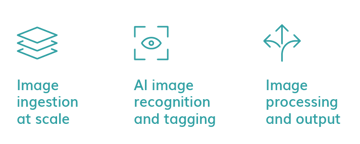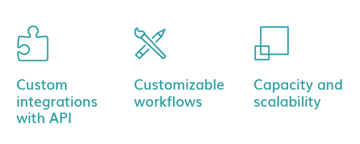Not only does it increase accuracy and efficiency, but it also makes process possible at a scale that’s simply impossible without automation.
Here are the must-have features for any organization interested in harnessing the awesome processing power of headless DAM to run and grow their business.
If you’re unfamiliar with headless DAM, head back to our previous article on the topic - Introducing Headless DAM: at-scale asset management for omnichannel marketers, publishers and ecommerce.


1. Image ingestion at scale
Users of headless DAM may be processing hundreds of millions of assets each year, from a diverse range of sources and different upload protocols. So headless DAM needs to be flexible enough to accept and understand high volumes of data and assets, regardless of where they originate.
It also needs to be intelligent enough to recognize and reject unsuitable assets, and report back so that problems can be addressed quickly. This prevents poor quality, off-brand or missing images online. It also represents a time saving compared to manual troubleshooting and reporting.
2. AI image recognition and tagging
AI image recognition and tagging mean that, when you upload images, the software automatically tags them to enhance searchability.
The software is intelligent enough to identify not only the content of the image – in terms of what the image features, colors etc – but also whether the image fits your brand and what emotions it might elicit in your audience.
Multiply this functionality across millions of assets – often uploaded by external sources – and it represents a huge time-saving at the input stage by automating and standardizing metadata.
Not only that but it reduces time searching for – and deploying – assets by expanding the range of search terms that can be used to identify them.
3. Image processing and output
In the omnichannel landscape – delivering rich media-based experiences across different platforms and media – being able to create multiple image renditions or variants is essential.
Your headless DAM should be able to deliver different crops, resolutions, and color pathways to optimize delivery to your audience. For example:
- Billboard – CMYK, high-res version with clipping path, capable of reproduction at a large size.
- Flyer for print – CMYK, lower-res version for easier handling and smaller reproduction.
- Website hero image – RGB version, web resolution, landscape crop.
- Social advert – RGB version, web resolution, cropped to specific dimensions of the platform.
With all of these different versions, maintaining control of metadata is vital to ensure no costly mistakes from accidental misuse. A good headless DAM will automatically update metadata – such as usage rights and product information – across all variants.
4. Custom integrations with API
The major benefit of headless DAM is derived from the fact it can integrate seamlessly with other systems. So look for a headless DAM with exceptional API flexibility, to provide maximum scope for an integrated workflow.
A good headless DAM solution should be able to integrate with content management systems, design and creative software, project and task management programs, print publishing tools, AI tagging tools, proofing and translation software, and more.
5. Customizable workflows
Headless DAM isn’t just about enhancing asset uploads and search. Integrations allow for customizable workflows that save time and increase efficiency.
For example, connect your headless DAM to Slack to send users a notification when a file has been added or edited. Or sync your DAM with your PIM to automatically update product listings with newly uploaded imagery.
This way, not only can your headless DAM improve workflows and efficiency in your other software, but other software can optimize workflows involving your headless DAM too. It creates a truly integrated software stack and a virtuous circle of process improvements.
6. Capacity and scalability
Even though headless DAM delivers effortless image processing and access at scale, it is often used by organizations that process a huge volume of assets – think millions, not thousands.
With the increased demand for online shopping, multichannel marketing and up-to-the-minute content, that volume is likely to grow. So you need to ensure that your selected software has the capacity to scale with your business.
Even if your business continues to process the same number of raw assets, the outputs you need to create could multiply as new technology, devices and channels become available. So choose a system that is scalable to suit your future needs.
Which is better: headless DAM or headless CMS?
When it comes to choosing between a headless DAM or a headless CMS, there isn’t a right or wrong solution, just different use cases.

Whilst a ‘content management system’ sounds like it is perfect for managing your content, the name is a little misleading now that the digital publishing and MarTech landscape has grown.
If unsure which system is going to be best to manage your ‘content’, consider:
- what content you need to manage
- where the content will be published
Headless DAM is designed specifically for businesses that need to process and publish digital assets – like images, video and artwork – across multiple publishing platforms.
A headless CMS is more focused on publishing content to websites and includes functionality for managing site structure, pages, and content like text, images, and video.
Headless DAM Headless CMS
Primary purpose is to manage unlimited digital assets, purpose-built for this work Asset management is a supplementary feature, secondary to overall website management Unrivalled and highly relevant metadata – enhanced by AI – makes assets more discoverable Metadata limited and related to website needs, not necessarily for asset searchability and deployment Understands the assets uploaded Describes the assets uploaded Huge capacity for large files – built for storage and scalability May have small capacity to house and process large files Automatically creates different versions of assets for different usage needs May optimize input images for display on web and mobile only
| Headless DAM | Headless CMS |
| Primary purpose is to manage unlimited digital assets, purpose-built for this work | Asset management is a supplementary feature, secondary to overall website management |
| Unrivalled and highly relevant metadata – enhanced by AI – makes assets more discoverable | Metadata limited and related to website needs, not necessarily for asset searchability and deployment |
| Understands the assets uploaded | Describes the assets uploaded |
| Huge capacity for large files – built for storage and scalability | May have small capacity to house and process large files |
| Automatically creates different versions of assets for different usage needs | May optimize input images for display on web and mobile only |
See the potential for headless DAM in your business? Check WoodWing Assets or contact us.



